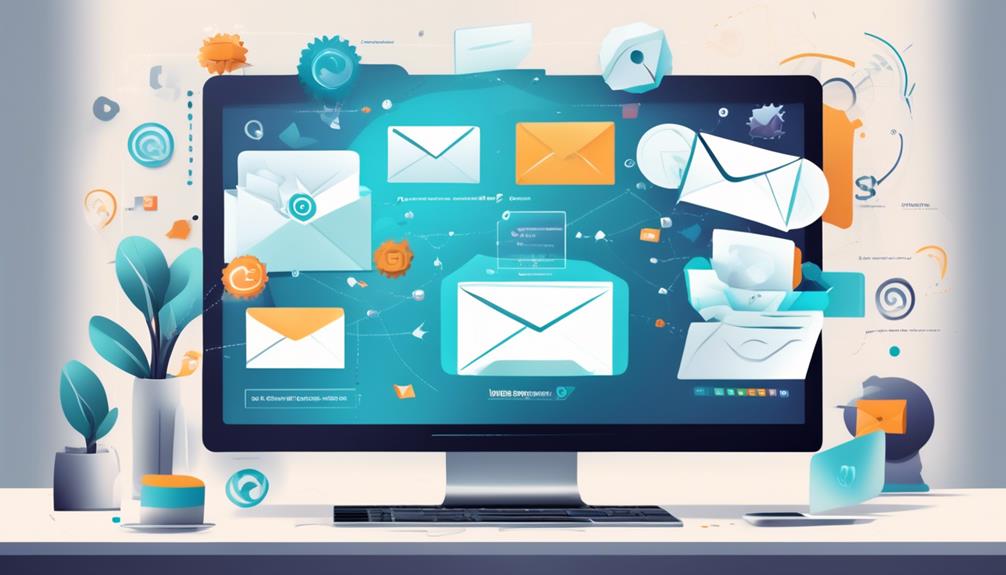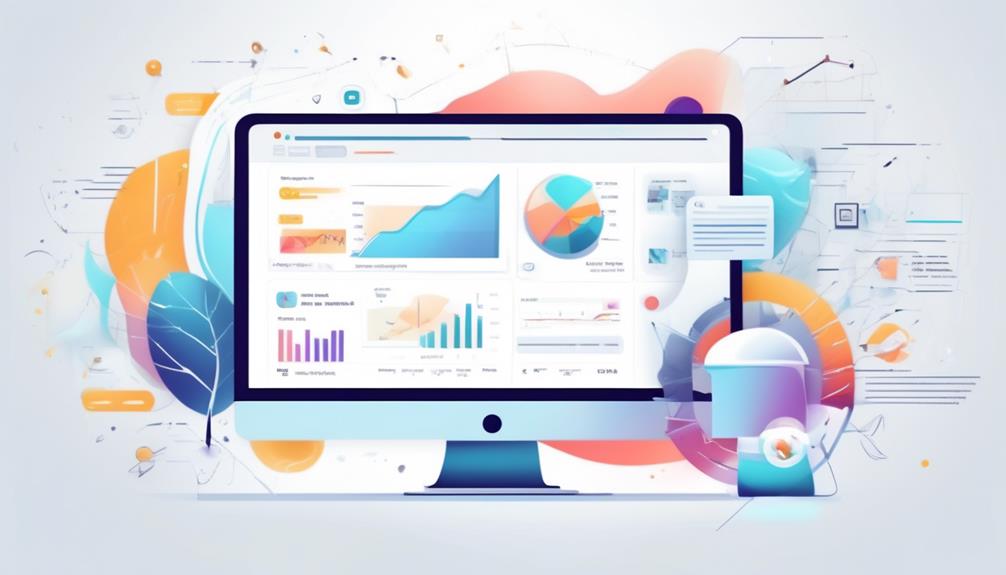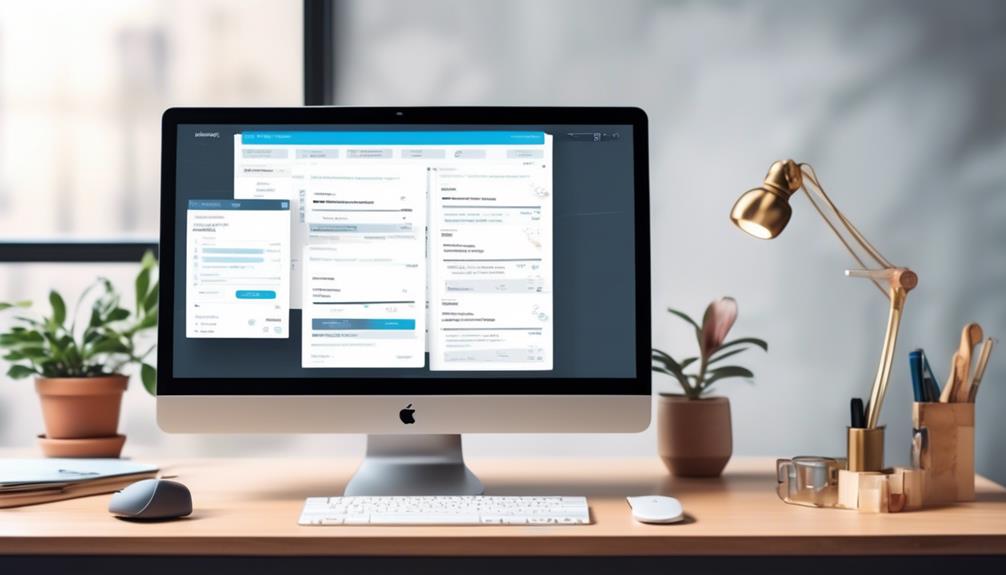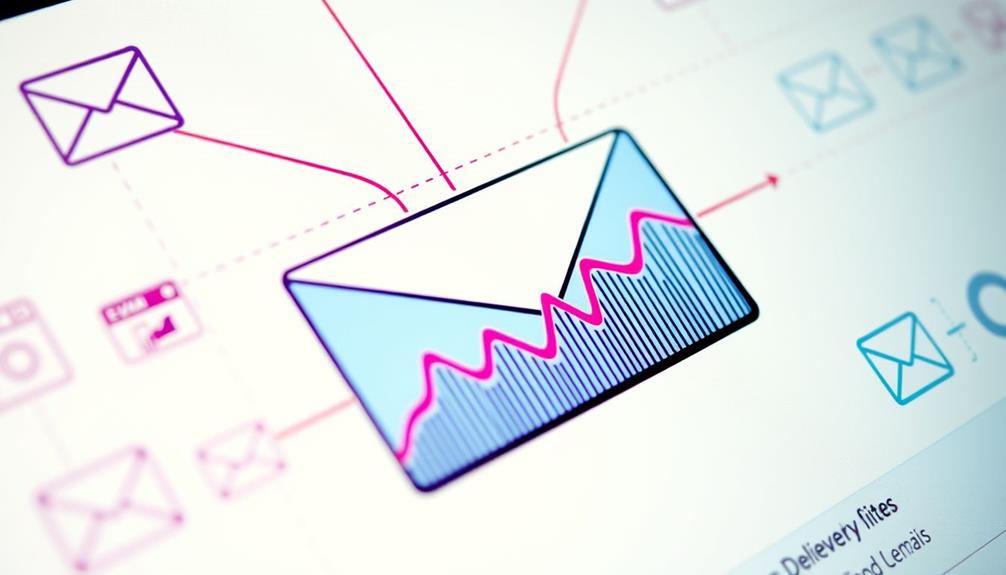In today’s business climate, the age-old adage “the early bird catches the worm” holds true, especially when it comes to email marketing. Our team has explored the realm of email marketing tools, and the discoveries we have made are truly intriguing.
From streamlining campaign creation to refining audience segmentation, these tools offer a plethora of capabilities that can revolutionize how businesses connect with their customers.
But before we dive into the specifics, there's a key aspect that we've uncovered – one that could potentially reshape your entire approach to customer engagement.
Key Takeaways
- Email marketing tools streamline the creation of campaigns, saving time and effort.
- These tools offer advanced features like segmentation, automation, and analytics to enhance audience understanding and engagement.
- Integration of advanced technology trends, such as workflow automation and retargeting ads, is a key factor in choosing the right email marketing tool.
- When considering an email marketing tool, scalability, ease of use, integration with current systems, and affordability should be taken into account.
Benefits of Email Marketing Tools
Using email marketing tools streamlines the process of creating and managing effective email campaigns for businesses, ultimately improving their marketing strategies. These tools offer a multitude of benefits, including advanced features such as segmentation, automation, and analytics.
Segmentation allows businesses to target specific audience segments with tailored content, maximizing relevance and engagement. Automation simplifies the process by scheduling emails, triggering responses based on customer actions, and nurturing leads through personalized workflows. The analytics provided by these tools offer valuable insights into campaign performance, enabling businesses to refine their strategies for better results.
Additionally, email marketing tools save time and effort, freeing up resources to focus on other aspects of the business. Many of these tools provide pre-designed templates and customization options, allowing businesses to create visually appealing emails without the need for extensive design expertise.
Furthermore, the integration of customer relationship management (CRM) features within these tools enhances audience understanding and engagement, ultimately leading to improved customer relationships and increased conversion rates.
Email Marketing Software in 2024

Let's take a look at the future of email marketing and the latest technology trends shaping the landscape in 2024.
As the digital marketing space continues to evolve, it's crucial to stay updated on the advancements and innovations that will impact our email marketing strategies.
Understanding the direction in which email marketing software is headed can provide valuable insights for staying ahead in the industry.
Future of Email Marketing
In 2024, the landscape of email marketing software is poised for further evolution as innovative technologies and user-centric features continue to shape the industry. The future of email marketing remains promising, with a focus on advanced features and enhanced user experiences.
Here's what to expect:
- Integration with Customer Relationship Management (CRM): Email marketing software will increasingly integrate with CRM systems to provide a seamless customer experience.
- Enhanced Audience Segmentation: There will be a focus on more sophisticated audience segmentation capabilities, allowing for highly targeted and personalized campaigns.
- AI-Powered Marketing Automation Solutions: The use of artificial intelligence in automating marketing processes will become more prevalent, offering improved efficiency and personalization.
- Tailored Solutions for Small Businesses: Email marketing platforms will continue to develop tailored solutions for small businesses, providing access to powerful digital marketing tools at affordable price points.
Latest Technology Trends
The top email marketing software for 2024, such as Salesforce Pardot, Campaigner, HubSpot Marketing Hub, Mailchimp, and Brevo, are at the forefront of integrating advanced technology trends to cater to diverse business needs.
These platforms are incorporating the latest technology trends to enhance marketing emails, streamline automation, and provide advanced CRM features. In particular, there's a significant focus on workflow automation, retargeting ads, and automation features to optimize the effectiveness of email marketing campaigns.
Mailchimp stands out for its integrated CRM and website-building features, making it ideal for e-commerce marketing, while Brevo is highlighted for its small business marketing automation capabilities.
Free email marketing apps like MailerLite and HubSpot are also recommended for their advanced segmentation and automation features, catering to businesses of varying sizes and needs.
Choosing the Right Email Marketing Tool
When selecting an email marketing tool, businesses must carefully consider the specific needs and scale of their operations to ensure the chosen platform aligns with their marketing objectives and resources. Here are important factors to consider when choosing the right email marketing tool:
- Scalability: Ensure the tool can grow with your business, offering advanced features such as automation and segmentation as your email campaigns become more sophisticated.
- Ease of Use: Look for platforms that provide user-friendly interfaces, drag-and-drop email builders, and a wide selection of free email templates to streamline campaign creation.
- Integration: Choose a tool that seamlessly integrates with your current systems, such as CRM software, and offers capabilities like landing page creation to support your marketing efforts.
- Affordability: Consider the pricing structure and ensure it aligns with your budget, especially for small business marketing, while still offering the necessary features for effective email campaigns.
Careful consideration of these factors will help businesses make an informed decision when choosing the right email marketing tool for their specific needs and goals.
Email Marketing Cost Analysis

Analyzing the costs associated with different email marketing software options is essential for making an informed decision that aligns with our business needs and budget. When evaluating email marketing cost analysis, it's crucial to consider the pricing structure, including monthly subscriptions, contact limits, and additional features offered by each email marketing software. Furthermore, we need to factor in the scalability of the email marketing software and how the costs may change as our business grows. Analyzing the potential return on investment (ROI) of the email marketing software in relation to the costs involved is also paramount. By comparing the cost-effectiveness of different email marketing software options, we can find the best fit for our business needs and budget.
| Email Marketing Tool | Pricing | Additional Features |
|---|---|---|
| Tool A | $50/month | Advanced segmentation, A/B testing |
| Tool B | $30/month | Marketing automation, CRM integration |
| Tool C | $100/month | Unlimited contacts, Custom reporting |
Considering the various factors such as pricing, features, and scalability, we can make an informed decision that ensures the optimal return on investment for our email marketing campaigns. Additionally, we should explore free email marketing tools that offer basic features for smaller email lists and contact management, providing a cost-effective solution for businesses starting their email marketing journey.
Getting Started With Email Marketing

To begin our journey into email marketing, we'll explore the different types of email marketing campaigns and the top email marketing software options for 2024.
Understanding these fundamentals is crucial for getting started with email marketing and developing an effective email marketing strategy. Here are some key points to consider:
- Types of Email Marketing Campaigns: Familiarize yourself with the various types of email marketing campaigns, including promotional, product update, digital newsletters, and transactional emails. This understanding will form the foundation of your email marketing strategy.
- Top Email Marketing Software: Research the best email marketing software options for 2024, such as Salesforce Pardot, Campaigner, HubSpot Marketing Hub, Mailchimp, and Brevo. Consider factors such as ease of use, features that align with your email marketing strategy, and customer journey capabilities.
- Utilizing Free Plans: Many email marketing software providers offer free plans. Evaluate the free offerings of platforms like MailerLite, HubSpot, Brevo, Mailchimp, and Sender. Consider the number of subscribers and sends included for free, as well as the ease of use and capabilities for audience segmentation.
- Best Practices and Ease of Use: When selecting an email marketing software, prioritize ease of use and best practices. Ensure that the platform aligns with your email marketing strategy and provides a seamless experience for your customer journey.
Email Marketing on Mobile Devices

When it comes to email marketing on mobile devices, mobile-responsive email designs are crucial. We need to ensure that our emails are optimized for small screens to provide a seamless user experience.
It's also important to use concise and engaging subject lines to capture the attention of mobile users.
Mobile-Responsive Email Designs
Mobile-Responsive Email Designs are essential for ensuring that your emails display properly and engage users effectively on mobile devices. Here are some key points to consider:
- Optimization: Utilize a drag-and-drop email editor to create mobile-responsive designs that adapt to different screen sizes.
- User Experience: Ensure that your audience segments receive emails that are optimized for their devices, leading to improved engagement.
- Consistent Testing: Regularly test your email designs across various mobile devices to guarantee a consistent user experience.
- Impact on Performance: Implementing mobile-responsive email designs can lead to increased open rates and click-through rates on mobile devices, ultimately driving the success of your email marketing campaigns.
Optimizing for Small Screens
As we shift our focus to optimizing for small screens in email marketing on mobile devices, it's crucial to ensure that our designs continue to adapt seamlessly across different screen sizes.
Utilizing responsive design within our email marketing software is essential for creating a seamless user experience. With a user-friendly interface and a template library tailored for small screens, we can easily design and send mobile-optimized emails to our small audience.
Additionally, incorporating pop-up forms on our landing pages can help grow our subscriber list and improve open rates on mobile devices. By prioritizing single-column layouts, concise subject lines, and easily consumable content, we can further enhance the mobile email experience and maximize engagement with our audience.
Integration With Other Software

Integration with other software enhances the functionality of email marketing tools by enabling seamless connectivity and data sharing within your existing tech stack. This integration offers a multitude of benefits, including:
- Streamlined Customer Data Management: Integration with CRM software such as Salesforce allows for the seamless flow of customer information, enabling targeted and personalized marketing campaigns based on customer interactions and behaviors.
- Targeted Marketing Based on Customer Purchase Behavior: Integration with e-commerce platforms like Shopify or WooCommerce facilitates the synchronization of customer data, empowering businesses to tailor their email marketing efforts based on customer purchase history and preferences.
- Enhanced Audience Targeting and Engagement: Email marketing tools often integrate with social media platforms like Facebook and Twitter, enabling businesses to expand their reach and engage with their audience across multiple channels.
- Insights into Email Campaign Effectiveness: Integration with analytics tools such as Google Analytics provides valuable insights into the performance of email campaigns, allowing for data-driven optimizations and improvements.
These integrations not only streamline processes but also enable businesses to leverage the full potential of their email marketing software, driving enhanced marketing automation, targeted communication, and data-driven decision-making.
Utilizing AI in Email Marketing

We've all experienced the frustration of receiving irrelevant or poorly timed marketing emails.
However, by utilizing AI in email marketing, businesses can personalize content and optimize send times to improve engagement and open rates.
AI tools can analyze data and provide insights for more effective email marketing campaigns, allowing businesses to target specific customer groups and make data-driven decisions for their strategies.
AI Email Personalization
Utilizing AI in email marketing revolutionizes the personalization of email content by analyzing individual preferences and behaviors to deliver tailored and engaging messages. Incorporating AI in email marketing features advanced email personalization capabilities, offering access to automation for streamlined processes.
The benefits of AI email personalization include improved open rates, click-through rates, and overall campaign performance. Furthermore, AI-powered tools can assist in segmenting the audience, predicting customer behavior, and dynamically adjusting email content to align with each recipient's unique interests and needs.
This level of automation not only saves time and resources but also enhances the effectiveness of email marketing campaigns, ultimately driving better results and ROI for businesses utilizing email marketing platforms.
Automated Content Optimization
By leveraging AI, Automated Content Optimization enhances email marketing by continuously improving content to boost engagement and conversion rates. This powerful feature of email marketing software utilizes AI to analyze recipient behavior and preferences, allowing for the creation of personalized and relevant email content.
Through machine learning, Automated Content Optimization refines and tailors email content over time, contributing to increased campaign effectiveness. Marketers can automate their email marketing efforts and efficiently send emails to segmented contact lists, ultimately generating more leads.
This advanced capability streamlines the process of creating and delivering high-performing email newsletters, contributing to overall marketing automation. Automated Content Optimization is a vital tool for mastering the art of email marketing, ensuring that messages reach the right audience at the right time with maximum impact.
Customization of Email Campaigns

To achieve higher engagement and relevance, personalized messaging tailored to different customer segments is essential in email campaigns. Customization allows for targeted communication that resonates with recipients, leading to improved open and click-through rates.
Here's how to effectively customize email campaigns:
- Utilize Segmentation: Divide your email list based on subscriber information such as demographics, purchase history, or engagement levels. This enables tailored content that speaks directly to the interests and needs of specific customer groups.
- Personalize Subject Lines and Email Addresses: Incorporate the recipient's name or other relevant details in subject lines and email addresses to grab attention and convey a personalized touch.
- Leverage Marketing Automation: Use email marketing software with automation capabilities to personalize and optimize campaigns based on customer behavior and preferences. This ensures that the right message is delivered to the right person at the right time.
- Utilize Free Templates and Email Design: Create visually appealing and brand-consistent emails using free templates and customizable email designs, enhancing the overall impact of your campaigns.
Solidifying Your Email Marketing Strategy

After mastering the art of customizing email campaigns to resonate with specific customer segments, the next step is solidifying our overall email marketing strategy to ensure consistent and impactful communication with our audience.
Solidifying our email marketing strategy involves more than just sending out a certain number of emails per month. It's about leveraging the full marketing automation capabilities of our email marketing tool to develop a comprehensive plan that aligns with our business objectives.
To solidify our strategy, we need to utilize features to help us reach customers effectively and efficiently. This includes utilizing segmentation and personalization to target the right audience with the right message at the right time.
Additionally, we should focus on optimizing the customer journey by delivering relevant content that nurtures leads and encourages conversions.
Free Email Marketing Services

We have found several free email marketing services that cater to businesses of all sizes and needs, including MailerLite, HubSpot, Brevo, Mailchimp, and Sender. When considering the best email marketing services with free plans, it's important to assess the offered features and limitations.
Here are some key considerations to keep in mind:
- Free Plans: Look for email marketing software that offers robust features within their free plans, such as customizable templates, automation tools, and segmentation capabilities.
- Free Trials: Some providers offer free trials of their premium plans, allowing you to test advanced features like dynamic content and A/B testing before committing to a paid subscription.
- Sends Per Month: Evaluate the number of free sends per month to ensure it meets your current needs and allows room for growth as you acquire new subscribers.
- Phone Support: While not commonly included in free plans, having access to phone support can be a significant factor when making a good choice for your email marketing needs.
Considering these factors will help you make an informed decision when selecting a free email marketing service that aligns with your business requirements and growth goals.
Email Marketing Services for Subscribers

With a myriad of options available, businesses can effectively engage and nurture their subscribers using top-rated email marketing services. These services provide a comprehensive suite of tools to manage subscribers and create targeted campaigns. The best email marketing software options for 2024, such as Mailchimp, Zoho Campaigns, Drip, MailerLite, and Brevo, offer advanced features to automate and personalize the subscriber experience. Through segmentation and automation, businesses can tailor their messages to specific subscriber groups, ensuring that the right content reaches the right audience at the right time.
Email marketing services empower businesses to create a series of emails that guide subscribers through a journey, from initial engagement to conversion. These services enable seamless management of subscriber lists, ensuring that the right subscribers receive the most relevant content. With advanced personalization options, businesses can create highly targeted campaigns that resonate with their subscribers, ultimately driving higher engagement and conversions.
Top Email Marketing Software of 2024

In assessing the top email marketing software of 2024, it's clear that Salesforce Pardot stands out as the best overall choice, offering outstanding features and AI-based decision-making tools.
For experienced email marketers, Campaigner is the top choice, providing highly customizable email marketing solutions and a powerful workflow designer.
HubSpot Marketing Hub is ideal for scalable marketing efforts, offering a comprehensive martech platform with integrated CRM and other features.
Mailchimp excels for marketing with e-commerce, featuring integrated CRM and website-building tools, and a consistent user interface.
Brevo is the best for small business marketing automation, offering advanced segmentation and automation workflows at a competitive price for unlimited contacts.
These top email marketing software options of 2024 cater to a wide range of needs, from easy-to-use solutions for beginners to advanced capabilities for seasoned professionals.
Additionally, they incorporate features such as SMS marketing and live chat, enabling email marketers to optimize their marketing efforts and engage with their audience effectively.
Which Email Marketing Tool Do You Recommend?
When it comes to email marketing tools, there are several options to choose from. Some popular email marketing tools discussed among professionals include Mailchimp, Constant Contact, and HubSpot. Each tool offers unique features and benefits, so it’s important to compare them to find the best fit for your business.
Frequently Asked Questions
Is Gmail an Email Marketing Tool?
Yes, Gmail is an email marketing tool when used in conjunction with other platforms. It's primarily a communication tool, but with the right strategies and integrations, it can effectively support marketing efforts.
With its large user base and various features, Gmail can be leveraged for targeted outreach, customer segmentation, and personalized messaging.
However, for more advanced capabilities, dedicated email marketing tools like Mailchimp may be preferable.
Is Email the Best Marketing Tool?
Yes, email is a powerful marketing tool.
It allows us to reach a wide audience, personalize content, and track performance.
However, it's essential to recognize that email is most effective when used in conjunction with other marketing strategies.
What App Is Used for Email Marketing?
We believe that email marketing tools play a crucial role in reaching our audience effectively. They offer diverse features like AI-based tools, social media integration, e-commerce support, and robust automation.
Options like Salesforce Pardot, Mailchimp, HubSpot Marketing Hub, Brevo, and MailerLite cater to different business needs. These tools empower us to create dynamic content, segment our audience, and track performance, essential for our marketing success.
Is an Example of Email Marketing Software?
Sure,
An example of email marketing software is Salesforce Pardot, which offers outstanding features and capabilities. It's a bit pricey, but it's worth considering for its functionality.
Campaigner and HubSpot Marketing Hub also provide highly customizable solutions suitable for midsize or larger businesses.
Mailchimp, a long-time player in the space, offers market-leading email marketing solutions and integrated CRM.
Brevo is a great option for small business marketing automation with competitive pricing.
Conclusion
In conclusion, email marketing tools are essential for businesses to effectively reach and engage with their audience.
Did you know that email marketing has an average ROI of 3800%?
With the right email marketing tool, businesses can harness the power of email to drive results and achieve their marketing goals.
So, if you're looking to boost customer engagement and increase conversions, investing in a reliable email marketing tool is definitely worth considering.










